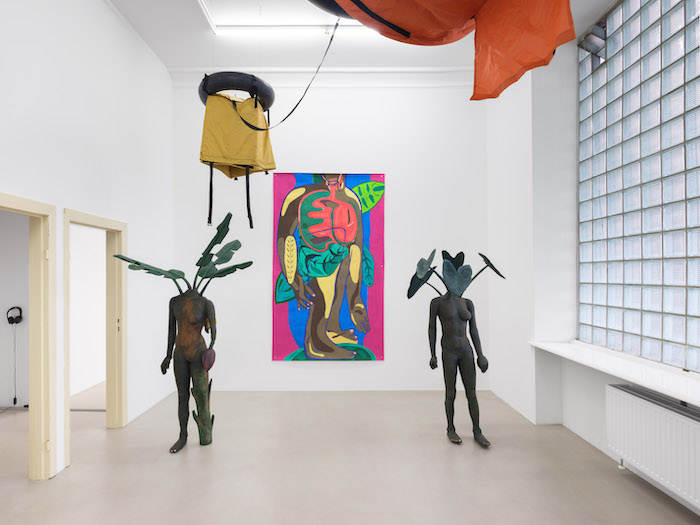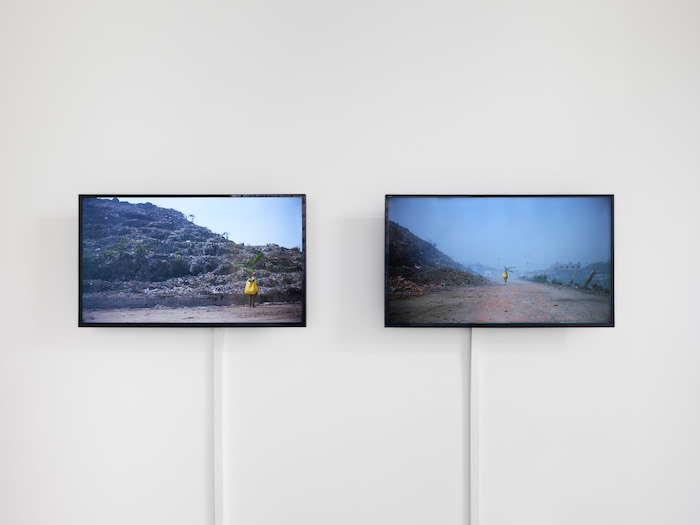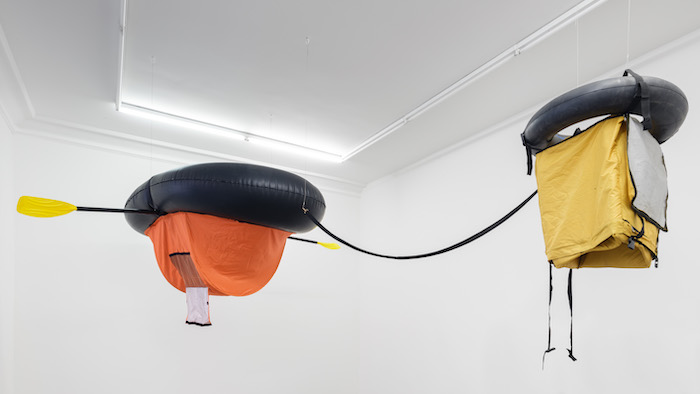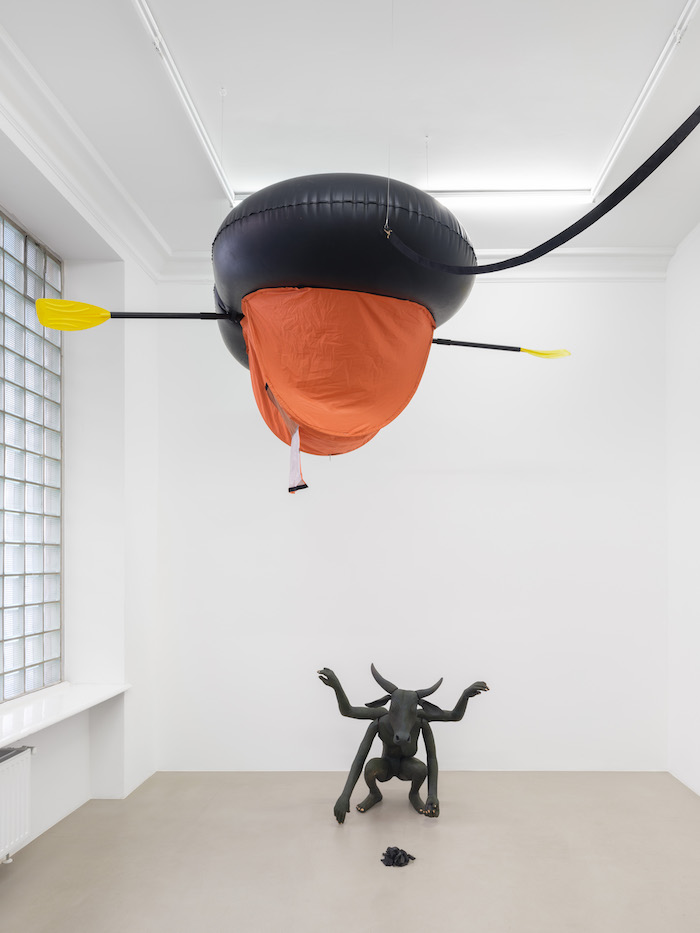by Eva Szwarc // Aug. 11, 2023
This article is part of our feature topic Wilderness.
To picture a place that is wild is to imagine unchecked growth, an unfurling of sorts—even something hostile and savage. There is no centre to be held; wilderness unfolds in all possible directions. These qualities pertain not only to the natural world. In fact, through the chasm lodged between the natural and human worlds, doesn’t the latter become its own kind of wilderness in relation to the other? Unchecked, uncentered, unfurling in all dizzying directions?
Arijit Bhattacharyya’s exhibition, ‘Sea of Forests,’ explores the possibility of removing this chasm. Spanning video, sculpture and painting, the work questions the respective roles of nature and civilisation. Can we dissolve the boundaries and re-learn from the natural world? If so, what may our futures look like? With an approach that is neither instructive nor conclusive, the artist looks toward ideas of unity and collaboration. In an even-handed swoop, the works are all (apart from one exception) titled under ‘From Forests We Are And Forests We Will Be’ (2023). A pair of wooden sculptures—standing far enough apart to appear like guardians to an invisible gate—are post-gender and post-human; the human body has metamorphosed partly into plant life. Five palm leaves sprout from the neck of one, the hand is a budding flower, the left leg a grounding trunk. I imagine this symbiotic process shifting over time, how the bodies would continue to blossom out and anchor and deepen their roots.

Arijit Bhattacharyya: ‘Sea of Forests,’ installation view, curated by Nuno de Brito Rocha, ChertLüdde, Berlin, 2023 // Courtesy of Arijit Bhattacharyya and ChertLüdde, Berlin, photo by Marjorie Brunet Plaza
I learn the significance of the plants—the banana tree and the taro—sprouting in the place of heads. In the Bengal Famine of 1943, which Bhattacharyya’s grandmother directly experienced, starvation led to the necessity of using each and every part of the plant. As recent soil samples have proven, the famine was not caused by extremities in weather conditions; rather, devastation was exacerbated by policy failure under British rule. Acts hostile and premeditated were carried out under the guise of so-called civilisation. The sculptures read as a visual transcendence, of both the power in knowledge and resistance, and a unity with the natural world, specifically plants previously left to grow wild across the land.
A video work, composed of animation, found footage and video performance, plays across two channels on the wall outside of ChertLüdde’s Bungalow space. In the animation, landscapes glimmer with mossy mounds and collective fireflies between banana trees. Animal avatars, of endangered species such as the otter or tiger, are shown in isolation as though held in a digital memory bank, through which they can be recalled. In the performance, a man carrying a banana plant on his back walks through densely packed markets, floats across a river and wanders across smoking beds of landfill. Which landscape has become a wilderness? The urban environment, with its polluted waters and smoking wasteland or that of the carried plant, uprooted and searching for shelter in a place that has forgotten it? If we wish to restore the power of nature, to learn to reconnect with it to save ourselves, where do we plant our feet—or roots—to begin?

Arijit Bhattacharyya: ‘From Forests We Are And Forests We Will Be,’ 2023, installation view of ‘Sea of Forests,’ curated by Nuno de Brito Rocha, ChertLüdde, Berlin, 2-channel video, animation, found footage and video performance; 4’39”; edition of 3 plus II AP // Courtesy of Arijit Bhattacharyya and ChertLüdde, Berlin, photo by Marjorie Brunet Plaza
The backpack, tent and floats—all used to move and transport the plant in the performance—are present in the exhibition space. Pinned to the ceiling, they are inverted. This inversion is a physical invitation to look with new perspectives and adjusted angles. Positioned as a heterotopic space, the work unsettles and assumes multiple ways of being read. It is also a suspended reminder of the uprooting, of both human and non-human beings, from their places of origin, which have been subjected to industrial and ecological devastation.

Arijit Bhattacharyya: ‘Sea of Forests,’ installation view, curated by Nuno de Brito Rocha, ChertLüdde, Berlin, 2023 // Courtesy of Arijit Bhattacharyya and ChertLüdde, Berlin, photo by Marjorie Brunet Plaza
A third sculpture in the space depicts Tar Baro, a deity in India who protects wild bison from being hunted. The land over which it presides has been subject to excessive mineral extraction and coal mining. With the wild bison gone and the belly of the land pillaged, the sculpture here is positioned bent over a small pile of coal. The deity holds one piece in one hand, as though either adding or removing the piece from the load. I choose to believe he is taking away from the load, upholding the hope that the burden humankind creates will become lighter. Later, I read in the exhibition text that the deity is in the act of eating the coal, and I oscillate between two thoughts. The first: the consumption is poisoning. The pillaging of the land does not lead only to an ecological deficit, but also a void of sacredness. On the other hand, the act is one of recovery. Through eating the coal, the deity speaks to the power of the land and the cyclical ability to endure that to which it is subjected.

Arijit Bhattacharyya: ‘Sea of Forests,’ installation view, curated by Nuno de Brito Rocha, ChertLüdde, Berlin, 2023 // Courtesy of Arijit Bhattacharyya and ChertLüdde, Berlin, photo by Marjorie Brunet Plaza
There is space for both readings; the works allow multiple stories to emerge and take shape. Like the fabric works hanging upside-down from the ceiling, Bhattacharyya invites altered perspectives and non-hegemonic ways of thinking. Optimistic and engaging, the works suggest the urgent necessity to re-integrate with the part of our world that has been segregated through unchecked destruction and extraction. The hybrid human-plant beings on view become a symbol of resistance, reminding us that we can learn from nature, which has increasingly escaped our careful consideration, and work toward bridging the deep chasms wrought by colonial and capitalist expansion.
Exhibition Info
ChertLüdde
Arijit Bhattacharyya: ‘Sea of Forests’
Exhibition: July 5–Aug. 26, 2023
chertluedde.com
Hauptstraße 18, 10827 Berlin, click here for map






















